Phecda, Gamma Ursae Majoris (γ UMa), is the primary component in an astrometric binary system located 83.2 light-years away in the constellation Ursa Major. With an apparent magnitude of 2.348, it is the sixth brightest star in the constellation. Phecda appears in the bowl of the Big Dipper, the most recognizable asterism in the far northern sky. It is one of the stars that outline the Great Bear’s hindquarters.
Phecda can be used to find the Owl Nebula (M97), the spiral galaxies Messier 106 and Messier 108, the Messier 81 and Messier 82 pair (Bode’s Galaxy and the Cigar Galaxy), and Regulus, the brightest star in Leo.
Star type
Phecda is a white hydrogen fusing dwarf of the spectral type A0 Ve. It has 2.412 times the Sun’s mass and is around 44.57 times more luminous than the Sun. The star is an exceptionally fast spinner, with a projected rotational velocity of about 184.5 km/s. Some astronomers estimate that it has a spin rate of 386 km/s at the equator. The star has an estimated age of around 333 million years.
Because of its fast spin rate, Phecda has the shape of an oblate spheroid. As a result, its radius at the equator is larger than its polar radius. The star has an equatorial radius of 3.385 solar radii and a polar radius of 2.186 solar radii.
Phecda is an example of gravity darkening. Because of its flattened shape, its poles are closer to the centre of mass than the equator. For this reason, they are much hotter than the equatorial bulge. In other words, they are gravitationally brightened, while the equatorial region is gravitationally darkened. The star has an effective temperature of 10,520 K at the poles and 6,751 K at the equator.

Phecda (Gamma Ursae Majoris), image credit: ESO/Digitized Sky Survey 2 (CC BY 4.0)
Phecda is classified as an Ae star, an A-type main sequence star embedded in an envelope of gas and dust that is adding emission lines of hydrogen to its spectrum. These lines are usually caused by a circumstellar shell of expelled material, a common feature among fast spinning stars.
Phecda is the primary component in an astrometric binary star system that also includes a class K main sequence companion. In astrometric binary systems, the companion cannot be detected visually. Its presence is only inferred based on the primary star’s wobble around a point in space. This indicates that it has an unseen companion and that the two stars are orbiting around a common centre of mass (barycentre).
The orange dwarf companion has an estimated mass of 0.79 solar masses. With a surface temperature of 4,780 K, it shines with 39.7% of the Sun’s luminosity.
Gamma Ursae Majoris A (Phecda) and Gamma Ursae Majoris B have an orbital period of around 20.5 years. They are separated by only 0.460 arcseconds in the sky.
Several studies have failed to detect the companion, so the wobble effect may be deceiving.
Facts
Phecda is part of the Big Dipper, the most familiar star pattern in the northern celestial hemisphere. It forms the asterism with Alioth (Epsilon Ursae Majoris), Alkaid (Eta Ursae Majoris), Mizar (Zeta Ursae Majoris), Megrez (Delta Ursae Majoris), Dubhe (Alpha Ursae Majoris), and Merak (Beta Ursae Majoris). Phecda, Megrez, Merak and Dubhe form the Big Dipper’s bowl, and Alkaid, Mizar and Alioth form the handle.
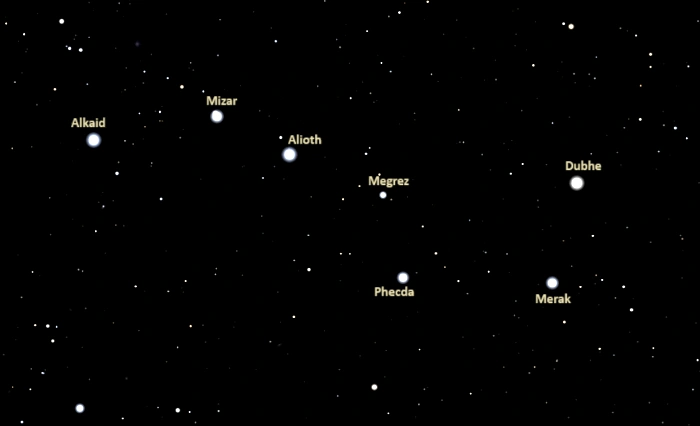
Big Dipper stars, image: Stellarium
Phecda is a member of the Ursa Major moving group (Collinder 285), a loose association of stars with an estimated age of 300 million years that share a common origin and motion through space. Other notable members of the group include all the Big Dipper stars except Alkaid and Dubhe, as well as the stream members Menkalinan (Beta Aurigae), Alphecca (Alpha Coronae Borealis), Skat (Delta Aquarii), Adhafera (Zeta Leonis), and Zhou (Beta Serpentis).
The Ursa Major association was discovered by the English astronomer Richard A. Proctor in 1869. Proctor was the first to notice that most of the stars of the Big Dipper have proper motions that are taking them toward a common point located in the constellation Sagittarius. With most of its stars sharing the same proper motion, the Big Dipper would not dramatically change over time, but as the stars at the ends of the asterism – Alkaid and Dubhe – do not belong to the group, the Dipper as we know it will eventually dissolve.
Sirius, the brightest star in Earth’s sky, was long believed to be a member of the Ursa Major moving group. However, its membership was brought into question by a 2003 study, which suggested that the bright star is much younger than other group members.
Among the middle five Big Dipper stars, which are members of the Ursa Major association, Phecda is the most distant, but not by much. Both non-members, Alkaid and Dubhe, lie further away.
Phecda is physically close to several other bright members of the Ursa Major moving group. A 2010 study found a physical separation of only 8.55 light-years (2.62 pc) between Phecda and the Mizar – Alcor system and 11 light-years between Phecda and Merak. In comparison, Sirius lies 8.60 light-years from the Sun and Proxima Centauri, the nearest star to the solar system, is 4.2465 light-years away. From a hypothetical planet orbiting Phecda, Merak would appear similarly bright to Sirius as it appears from Earth.
Phecda is the sixth brightest star in Ursa Major, after Alioth, Dubhe, Alkaid, Mizar, and Merak. Shining at magnitude 2.438, it is on average the 85th brightest star in the sky. It is about as bright as Sabik (Eta Ophiuchi) in the constellation Ophiuchus, Scheat (Beta Pegasi) in Pegasus, and Aludra (Eta Canis Majoris) in Canis Major.
Phecda is only slightly fainter than Izar (Epsilon Boötis) in Boötes, Enif (Epsilon Pegasi) in Pegasus, Kappa Scorpii in Scorpius, and Ankaa (Alpha Phoenicis) in Phoenix. It just outshines Alderamin (Alpha Cephei) in Cepheus, Markeb (Kappa Velorum) in Vela, Aljanah (Epsilon Cygni) in Cygnus, and Markab (Alpha Pegasi) in Pegasus.
Phecda’s spectrum has been used as one of the anchor points for the Morgan-Keenan (MK) spectral classification system since 1943. This was the year of the first publication of the list of standard stars in The Atlas of Stellar Spectra by W. W. Morgan, P. C. Keenan and E. Kellman. The spectra of these stars serve as stable anchor points used to classify other stars.
Phecda has the Bayer designation Gamma Ursae Majoris even though it is only the sixth brightest star in the Great Bear constellation. The German astronomer Johann Bayer, who assigned the Greek letter designations to bright stars, was generally guided by the order of magnitude and not by stars’ individual brightness. With the stars of Ursa Major, he went from west to east, or from front to back. Dubhe and Merak, the outer stars of the Dipper’s bowl, got the Bayer designations Alpha and Beta Ursae Majoris. Alioth, the constellation’s brightest star, was assigned the letter Epsilon. Megrez and Phecda, the inner stars of the bowl, were given the Greek letters Delta and Gamma.
Ancient Arabic astronomers saw the stars of the Big Dipper’s bowl as a coffin or bier, with the stars of the Dipper’s handle representing mourners. The constellation symbolized a funeral and its slow circular motion around the north celestial pole was associated with the slow movement of a funeral procession.
Name
The name Phecda (pronunciation: /ˈfɛkdə/) refers to the star’s position in the Great Bear constellation. It is derived from the Arabic phrase fakhth al-dubb, meaning “the thigh of the bear.”
The name was officially approved for Gamma Ursae Majoris Aa by the International Astronomical Union’s (IAU) Working Group on Star Names (WGSN) on July 20, 2016. Even though it formally applies only to the primary component in the system, it has traditionally been used for the whole star system.
The name was historically also spelled Phacd, Phad, Phekda, Phekha, Phegda, Al Hecda, and Fekda. Gamma Ursae Majoris was sometimes also called Phact or Phachd. The name Phact (from the Arabic fākhitah, meaning “ring dove”) now formally applies to Alpha Columbae, the lucida of the southern constellation Columba (the Dove).
In traditional Chinese astronomy, Phecda was known as the Third Star of Northern Dipper (北斗三). Northern Dipper was an old Chinese asterism that corresponded to the Big Dipper. It was part of the Purple Forbidden Enclosure and represented the imperial palace. In China, Phecda is also known as Tiān Jī (天璣), the Star of Celestial Shining Pearl.
The Hindu name for Gamma Ursae Majoris is Pulastya, after one of the Saptarishis (Seven Great Sages) in Hindu mythology. Pulastya was one of the Prajapati, Vedic deities of Hinduism.
Location
Phecda is easy to find because it is part of a bright and recognizable northern asterism, the Big Dipper. The asterism is formed by seven bright stars of Ursa Major constellation: Alkaid (η UMa), Mizar (ζ UMa), Alioth (ε UMa), Megrez (δ UMa), Phecda (γ UMa), Dubhe (α UMa) and Merak (β UMa).
Phecda is the lower-left or southernmost star of the Big Dipper’s bowl.
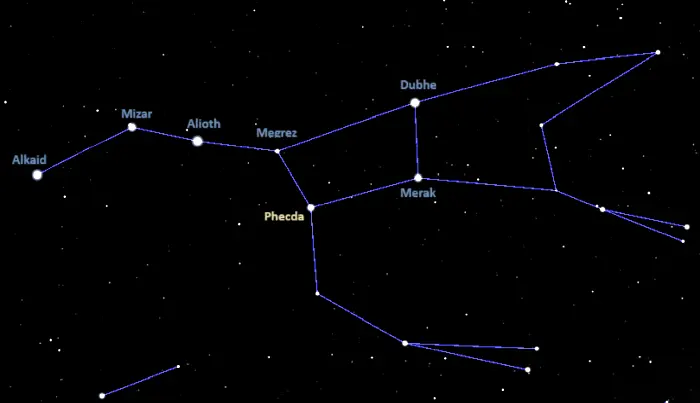
The location of Phecda (Gamma Ursae Majoris), image: Stellarium
Phecda can be used to find several bright deep sky objects. The barred spiral galaxy Messier 109 lies just southeast of the star. It is the brightest galaxy in the M109 Group, which also includes the barred spiral galaxy NGC 3953 and more than 50 other galaxies. The M109 Group is a member of the Ursa Major Cluster, a galaxy cluster particularly rich in spiral galaxies. NGC 3718 (also designated Arp 214), located near Phecda, is one of the cluster’s brighter members.
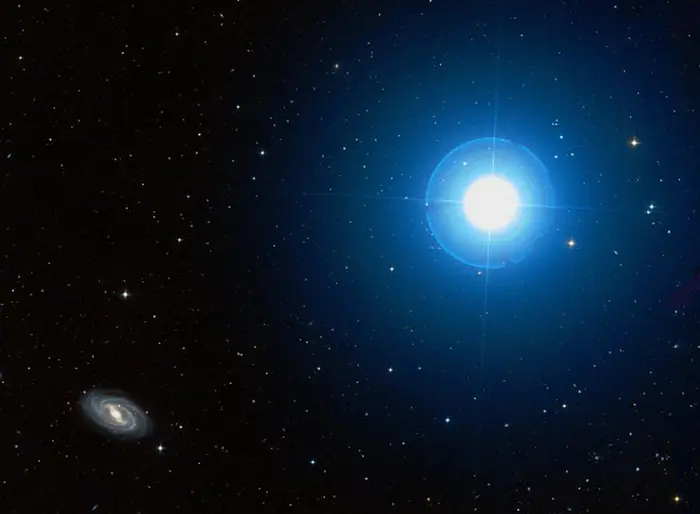
Phecda and Messier 109, image credit: ESO/Digitized Sky Survey 2 (CC BY 4.0)
The bright planetary nebula Messier 97, also known as the Owl Nebula, and the barred spiral galaxy Messier 108 can be found using Phecda and Merak, the other star at the bottom of the Big Dipper’s bowl. The Owl Nebula is located about 2.5 degrees from Merak in the direction of Phecda and Messier 108 appears in the same field of view, about 48 arcminutes northwest of the nebula.
The spiral galaxy Messier 106 can be found by extending an imaginary line from Dubhe through Phecda. The galaxy lies in the neighbouring constellation Canes Venatici, the Hunting Dogs.
In the other direction, Phecda and Dubhe can be used to find the famous Messier 81 and Messier 82 pair (Bode’s Galaxy and the Cigar Galaxy). The galaxies lie along the line drawn from Phecda through Dubhe and extended by the same distance as that between the two stars.
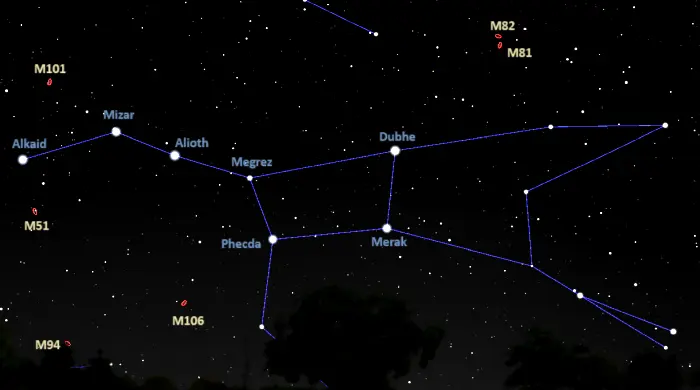
Dubhe, Phecda, Messier 81 and Messier 82, image: Stellarium
A line extended from Megrez through Phecda points in the direction of Regulus (Alpha Leonis), the brightest star in the constellation Leo. The bright Regulus appears at the base of the Sickle of Leo, an asterism that represents the Lion’s head and mane.
Constellation
Phecda is located in the northern constellation Ursa Major, the Great Bear. Ursa Major is one of the 48 Greek constellations, listed by the Greco-Roman astronomer Ptolemy in the 2nd century CE. In Greek mythology, it is associated with the nymph Callisto, who was turned into a bear by the goddess Hera.
The constellation has been known since prehistoric times. The bright asterism formed its seven main stars has been known by many different names, including the Big Dipper, the Plough, the Great Wagon, the Saucepan, and Charles’ Wain.
Ursa Major is the third largest constellation in the sky, after Hydra and Virgo. It stretches across 1,280 square degrees of the northern sky and is the largest constellation in the northern celestial hemisphere.
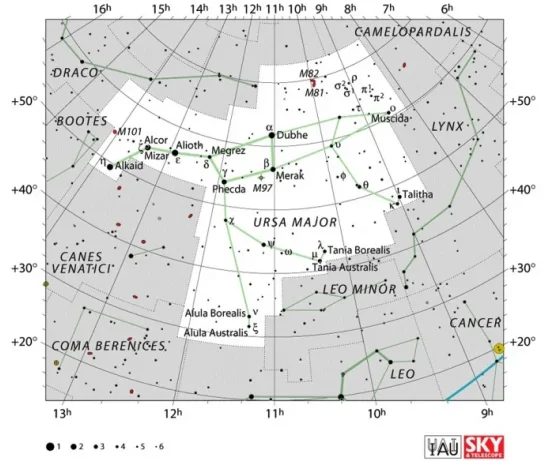
Ursa Major constellation map by IAU and Sky&Telescope magazine (Roger Sinnott & Rick Fienberg) (CC BY 3.0)
The brightest stars in the Great Bear constellation are the evolved A-type stars Alioth and Merak, the orange giants Dubhe and Psi Ursae Majoris, the hot, blue, B-type main sequence star Alkaid, the Mizar and Alcor star system, the white subgiant Merak, the red giant Tania Australis, and the A-type star Talitha. The last two of these are part of the Three Leaps of the Gazelle, an asterism that corresponds to the paws of the Great Bear.
Other notable stars in Ursa Major include the yellow bright giant Muscida, the variable contact binary system W Ursae Majoris, the Sun-like yellow dwarf Chalawan (47 Ursae Majoris) with three orbiting planets, the K-type dwarf HIP 57274, also with three exoplanets, and the red main sequence star Lalande 21185, the fourth nearest star system to the Sun (after Alpha Centauri, Barnard’s Star, and Wolf 359).
Ursa Major hosts many interesting deep sky objects. These include the bright galaxies Messier 101 (the Pinwheel Galaxy), Messier 81 (Bode’s Galaxy), Messier 82 (the Cigar Galaxy), the spiral galaxies Messier 108, Messier 109 and NGC 3079, the grand design spiral galaxy NGC 3310, and the planetary nebula Messier 97 (the Owl Nebula).
Ursa Major is circumpolar to most northern observers and can be seen throughout the year. The best time of the year to observe its stars and deep sky objects is during the month of April, when the constellation is high above the horizon in the early evening. The entire constellation can be seen from locations north of the latitude 30° S.
The 10 brightest stars in Ursa Major are Alioth (Epsilon UMa, mag. 1.77), Dubhe (Alpha UMa, mag. 1.79), Alkaid (Eta UMa, mag. 1.86), Mizar (Zeta UMa, mag. 2.04), Merak (Beta UMa, mag. 2.37), Phecda (Gamma UMa, 2.438), Psi Ursae Majoris (mag. 3.01), Tania Australis (Mu UMa, mag. 3.06), Talitha (Iota UMa, mag. 3.14), and Theta Ursae Majoris (mag. 3.166).
Phecda – Gamma Ursae Majoris
| Spectral class | A0Ve + K2 V |
| U-B colour index | +0.008 |
| B-V colour index | -0.013 |
| Apparent magnitude | 2.438 |
| Absolute magnitude | 0.4 |
| Distance | 83.2 ± 0.8 light years (25.5 ± 0.3 parsecs) |
| Parallax | 39.21 ± 0.40 mas |
| Radial velocity | -11.90 ± 0.7 km/s |
| Proper motion | RA: +107.68 ± 0.29 mas/yr |
| Dec.: +11.01 ± 0.29 mas/yr | |
| Mass (γ UMa A, γ UMa B) | 2.412 M☉ (2.352 – 2.474 M☉), 0.79 M☉ |
| Luminosity (γ UMa A, γ UMa B) | 44.57 L☉ (40.96 – 47.96 L☉), 0.397 L☉ |
| Radius (γ UMa A) | 3.385 ± 0.08 R☉ (equatorial), 2.186 R☉ (polar) |
| Temperature (γ UMa A, γ UMa B) | 6,751 K (equatorial), 10,520 K (polar); 4,780 K |
| Age (γ UMa A) | 333 million years (250 – 376 Myr) |
| Rotational velocity (γ UMa A) | 184.5 km/s (148.9 – 217.1 km/s) |
| Surface gravity (γ UMa A) | 3.79 cgs |
| Constellation | Ursa Major |
| Right ascension | 11h 53m 49.84732s |
| Declination | +53° 41′ 41.1350” |
| Designations | Phecda, Gamma Ursae Majoris, Gamma UMa, γ Ursae Majoris, γ UMa, Phad, 64 Ursae Majoris, HD 103287, HR 4554, HIP 58001, SAO 28179, FK5 447, GC 16268, GCRV 7177, BD+54 1475, AG+53 826, PPM 33292, PLX 2749.00, NSV 5379, SKY# 22423, WEB 10387, RAFGL 4831S, ROT 1756, AC2000 1609350, CEL 4005, CNS5 2918, CSV 101229, EM* MWC 583, GSC 03833-01034, JP11 2124, IRC +50215, GEN# +1.00103287, N30 2769, PMC 90-93 321, UBV 10684, UBV M 17477, RX J1153.8+5341, 1RXS J115352.3+534153, RX J1153.8+5341 1, uvby98 100103287, IRAS 11512+5358, 2MASS J11534983+5341408, TD1 15932, TIC 11895653, TYC 3833-1034-1, Gaia DR2 792588939772065536, Gaia DR3 792588939773693568, SHY 227A, WDS J11538+5342A |